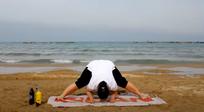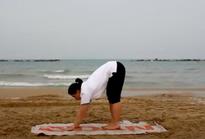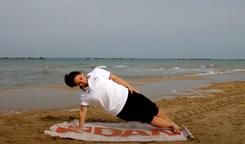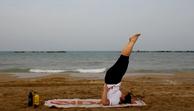

DIVE FITNESS
Cardiovascular Fitness may reduce the risk of DCS
Ever thought about engaging in Yoga?
FOREWORD
As there are still conflicting opinions about it whether any exercise and to what extent exercise should be done before a scuba dive, it is recommended not to overdo it nor overexert yourself in anyway.
If you engage in heavy exercise, then be sure to wait 24 hours (or longer) before you go scuba diving, and certainly don't do any heavy or strenuous exercise after a scuba dive. To be safe, wait for 24 hours or longer in order not to trigger any nitrogen bubbles to "blow up".
Still, exercise in general has a lot of beneficial effects also for scuba diversthat's what this article is about...
As you were able to read in one of our last Alert Diver Newsletters, the PHYPODE research project investigated the so-called preconditioning as an effective and individual way to reduce the risk of DCS. Important to mention here: preconditioning is a pre-dive activity, that you engage in before you go diving. (Never do it afterwards!)
WHAT EXACTLY IS PRECONDITIONING?
Research findings suggest that there is obviously an individual susceptibility to DCS and that a lot of this has to do with differing endothelium quality. The endothelium is the inner layer of your blood vessels. In general, it is assumed that there are two possible "Decompression Stress" reducing mechanisms: a biochemical and a mechanical one.
In two compared studies, the researcher Z. Dujic from the School of Medicine at the University of Split conducted research on pre-dive cardiovascular exercise within the scope of the PHYPODE project. He investigated pre-dive aerobic running and pre-dive anaerobic cycling. He found that both activities had a protective effect and reduced microparticles (which can act as seeds for bubble formation).
Another researcher, Ran Arieli, proposed that bubbles build on hydrophobic nucleic spots on the inner layer of blood vessels, especially if the surface of the blood vessels is “rough”. Consequentially, keeping one’s vascular system in good condition and oneself in good shape, might lower the risk of DCS.
But not everybody likes to go on a sauna session or is able to run for 45 minutes or cycle half an hour on a spinning bike in a gym. This could be due to the lack of facilities, the person’s age or health as well as cultural or other reasons.
Why not engaging in some mild to intense Yoga exercises (e.g. Vinyasa Power Yoga style) instead? Yoga seems to combine a lot of the beneficial effects mentioned above.
What researchers found…
Basically, exercising will increase ventilation and shake off bubbles. Heat stress will produce Heat Protection Proteins (HPPs) which prevent bubble formation, sufficient hydration well before diving is believed to have a preventive effect by “flushing” microparticles out of the system Whole-body external mechanical vibration (like a bumpy boat ride) is believed to shake off bubbles Vibration positively influences the lymphatic system's role in eliminating the bubble forming micronuclei by increased lymphatic drainage
Consequentially, researchers have shown that mild pre-dive cardiovascular activation (e g , sauna sessions, running, and cycling) has an effective preconditioning effect. An effective cardiovascular activity should involve bringing your pulse up to approximately 150 beats per minutes (bpm), depending on age.
For example, Vinyasa Power Yoga connects different Yoga in a dynamic flow of movements, thereby strengthening and relaxing muscles. In an advanced stage and done regularly, Yoga will stimulate all bodily systems and can improve your muscle strength, circulation, the activity of your lymphatic system and the flexibility of your limbs, tendons and ligaments.
Although no specific dive physiology research study has been conducted on the effect of Yoga regarding reducing or eliminating micronuclei from the vascular system, these Yoga qualities seem to be quite promising in this way.
Combined with the right breathing techniques, Yoga might also help to release metabolic waste products, like carbon dioxide and other toxins from your body.
Vinyasa Power Yoga seems to be applicable to some real world dive scenarios as well. If you are on a live-aboard or a remote island where there is neither a bike nor a treadmill, you can do it. For others with hip or knee problems it might be a good alternative to stay fit.
THE OBVIOUS ADVANTAGES ARE…
You do not need electricity or a gym. In fact, you do not need a lot of space either. You can do it in your hotel room or on the beach. All you need is a large towel or a Yoga mat and approximately 60 minutes of your time.
THE HEALTH BENEFITS FOR YOU ARE…
Vinyasa Power Yoga will strengthen not only your mind but also your muscles. If your muscles are in good shape, they will support your cardiovascular system in pumping the blood back to your heart. Good circulation and a strong cardiovascular system including a strong heart are vitally important for divers.
In addition, Yoga will let you relax as well as focus, which is a good state of mind for a later dive. And, not to forget, after days or weeks of carrying heavy equipment, your muscles might be sore. Sore muscles not only hurt but, in fact, in this state they can clump, compressing nerves and blood vessels starting a vicious circle of pain. Some divers may go for a massage but with Yoga you can actually help yourself releasing muscle pain. Especially, as a diver you don’t want your hip muscles to be tight and compress your nerves and blood vessels that lead to your legs. A well functioning circulation is believed to release bubbles more easily by transporting them quickly to the lungs where they can be exhaled.
HOW IT WORKS…
Vinyasa Power Yoga was actually developed in the United States during the 80ies. By repeating the exercises quickly and several times, heat will be generated and will raise the body temperature having a dilating effect on the blood vessels, including the ones in the skin.
While sweating from this exercise, toxins are carried out of the body – an additional beneficial effect. Increased blood circulation diminishes stiffness of muscles, tendons, ligaments, and joints. Regular practice lengthens muscles adding to more flexibility over time, and breathing techniques will open up the airways, relax the respiratory musculature, increase ventilation of the lungs and sinuses and will fill your whole body with fresh air.
Yoga is not necessarily slow. By repeating different Yoga positions rapidly one after the other and over and over again, you will soon be able to increase your heart rate, especially if you exercise in a warm environment. Also, holding positions for a relatively long time can be pretty exhausting.
REMEMBER…
Inactivity is very bad for anyone, divers not excluded. Thus, any mild predive exercise can be valuable. Yoga might just be the right activity for you… but remember:
Although Yoga has the reputation of being a universal remedy, it must be stressed here that it has not yet been scientifically validated whether Yoga can reduce the risk of DCS. Only generally it can be said that a healthier cardiovascular system is less prone to DCS than an unhealthier one.
CALCULATING YOUR OWN HEART RATE…
It is advisable to know your maximum heart rate which is influenced by your age due to increased stiffness of the arteries. As a point of reference you subtract your age (in years) from 220. Generally, to exercise effectively in terms of cardiovascular training, your heart rate should reach a range just below that maximum heart rate of yours.
Beginners should try to achieve approximately 65-75% of their maximum heart rate while advanced persons can try to achieve up to 75-85%.
If no pulse/heart rate monitoring device is available, just look at your watch and count the pulse you feel with your fingers for 15 seconds and then multiply by 4.
HEART RATE EXAMPLE FOR A 30-YEAR-OLD PERSON:
Personal maximum: | 220 – 30 years: | 190 bpm
Beginner: | 65% - 75%: | 123.5 – 142.5 bpm
Advanced: | 75% - 85%: | 142.5 – 161.5 bpm
HEART RATE EXAMPLE FOR A 60-YEAR-OLD PERSON:
Personal maximum: | 220 – 60 years: | 160 bpm
Beginner: | 65% - 75%: | 104 – 120 bpm
Advanced: | 75% - 85%: | 120 – 136 bpm
Breath-hold divers have long discovered the benefits of Yoga for themselves. It’s finally time to get scuba divers officially involved as well… To give you a taste of Yoga, we added a few short video clips (see links below). Positions may look simple but they are not. Beginners are not expected to hold them for long or be able to do them perfectly. Improvement will come over time when practiced regularly. It’s recommended to engage in Yoga under a trainer’s instruction. Once you have understood the basic concept, you can do it anywhere every day all by yourself. The video clips show only a selection of the entire existing Yoga spectrum. You can adjust duration and repetition to your own level of fitness by holding positions for less long and doing more repetitions – or vice versa.
Please consult your physician before you engage in Yoga. For people with a cervical vertebrae condition, or similar, some positions may be practiced with caution or not be practiced at all!
Watch video clips here: Sun salutation whole-body warm-up. Repeat 6x, each leg 3x.

Spread feet intense stretch pose stretches gluteus maximus, lower back, shoulder and neck. Try 2-3x, hold for 2 min.

Warrior I
strengthens leg and upper arm musculature, while stretching the other side's leg and upper arm muscles. Repeat each leg 2-3x, hold for 2 min.

Warrior II strengthens muscles of the flexed leg and opens up the hip. Repeat each leg 2-3x, hold for 2 min.

Boat strengthens the abdominal muscles (i.e. rectus abdominis), stretches the hamstrings. Repeat 2-3x, hold for 1:30 min.

Upward facing dog
abdominal stretch and strengthening pose for gluteals. Repeat 2-3x, hold for 3 min.

Locust strengthens gluteals and longissimus, stretches quadriceps, rectus abdomini and psoas. Repeat 2-3x, hold for 3 min.

Downward facing dog
effective whole-body stretch (rear side), while strengthening triceps, upper back muscles, quadriceps and abductors. Hold for 4 min.

Sage
arm-balancing pose, strengthening shoulder, wrist and elbow stabilizing muscles, quadriceps, abductors, spinal muscles of the back and abdominal muscles of the front. Biceps stretch. Try each arm for 1 min, 2-3x.

Plough
effective shoulder stretch and full rear side stretch of the leg. It strengthens quadriceps, abductors, and biceps. Try 2-3x, hold for 1 min.

Child pose
relaxes neck and back. Relax for 2-3 min.

www.alertdiver.eu
Yoga performance by Francesca Guerrieri from Karate school Roseto degli Abruzzi, Italy. Set, Costume, Location & Logistics Manager: Vanessa Rapini/DAN Europe Text, camera & editing: Caren Liebscher/DAN Europe
